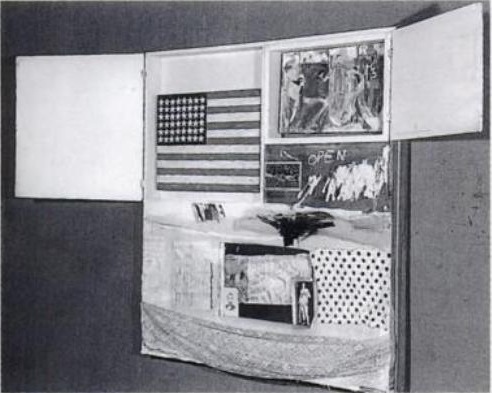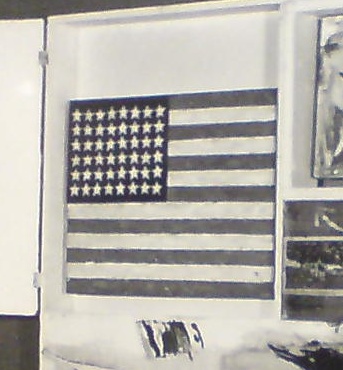
Two months. I’d feign shock, but frankly, it’s been almost a year since I figured it out, and I’m only now posting it.
Last January, while going through the newly opened Castelli Gallery Collection at the Archives of American Art, I found some documents relating to the “loss” of the Jasper Johns Flag which had been inside Robert Rauschenberg’s 1955 combine, Short Circuit. [Remember, it was probably the first flag painting Johns made, and certainly the first one ever shown, by an easy three years. Complicated.]
There were notes about calling the NYPD 9th precinct and some preliminary paperwork for an insurance claim, all commencing on Tuesday, June 8, 1965. The insurance adjuster’s follow-up memo says a “theft” occurred, not just of the Johns, but of a similarly small sculpture edition by Roy Lichtenstein, on 6/6/1965, the previous Sunday. From the gallery’s storage facility on 1st Avenue. Obviously, they called right away, as soon as they found out.

Actually, no. I decided to track down the police report, only to run into a dead end. There were no reports of art thefts on or around the 8th at all. After a couple of fishing expeditions by mail, a kindly NYPD records officer took pity on me, and returned one of my $10 checks with a phone number on it. I called, explained what I was looking for, and she said she’d try to expand the search a bit when and if she could.
A few weeks later, just about a year ago now, I got a single page form with no details, just the basics of the police report. The date of the theft was listed as April 15th, nearly two months before Castelli called either the police or the insurance company.
Which means either the gallery didn’t realize the flag painting had been removed, or they did, and it spent two months trying to figure out what happened before giving up and filing an insurance claim.
It was the more interesting of the two.
Last winter, I reached Edward Meneeley, an artist and photographer who knew Johns and Rauschenberg well in the 1950s. Meneeley published the Portable Gallery Bulletin, a subscription newsletter/slide service which was used by schools, libraries and scholars to keep up with the latest New York shows. The Bulletin ran Johns’ only published comments on Short Circuit in 1962. Johns wrote a letter to the editor to refute the charge that Rauschenberg’s refusal to allow the Bulletin to distribute images of Short Circuit was due to art world “politics” and an attempt to rewrite history.
Meneeley recalled the hubbub surrounding the disappearance of the Johns Flag. Ed said, he had been photographing Ileana Sonnabend’s inventory/collection at the warehouse, and so he was there quite a bit during the spring and summer of 1965. He was asked a couple of times if he’d seen or knew anything, and so was “everyone else.” [I took this to mean people who were working around the galleries and the warehouse.] Which sounds like there was a general awareness that the flag painting had disappeared.
[Meneeley also said he thought Short Circuit had ended up in Sonnabend’s collection, but I asked Antonio Homem about this, and he confirmed that this had never been the case. Michael Crichton had originally written the work was in Castelli’s collection, but this was also not the case; the Rauschenberg Foundation told me it remained in Bob’s collection until he died.]

I’d thought that a two-month search for a missing Johns painting would leave a trace of some kind in the Castelli Archives, but if it’s there, I couldn’t find it. Once I had the April 15 date, I went through every page of the Gallery’s notebook and memo collection, as well as Castelli’s own daily calendar. There are lunches with RR, and finally, around June 11th, mentions of “JJ Insurance,” [little detail above] but otherwise, nothing.
There are plenty of mentions of insurance for all kinds of people in the archive materials, and other instances of JJ and RR claims–works were getting insured, damaged, assessed, and repaired all the time–so the mention above could be unrelated. But it does make me wonder if the claim for Johns’ Short Circuit flag painting was filed on behalf of Rauschenberg–or Johns? Does the practical fact that when it’s missing, Flag was being treated as an autonomous Johns painting affect how it should be seen art historically? In other words, can we thus assume it was a Johns painting, and not–or not merely–the raw material of a Rauschenberg combine?
Ed’s account also makes me curious about how widely known the 1965 theft–I guess we can call it that now–actually was. How many people were questioned? Did people gossip and speculate about it for a while? Who else knew? And was it registered as stolen with the appropriate industry databases? A year and a half, and I finally know the answer to that last question.
“Loss of Painting – American Flag – Jasper Johns”
Skip to content
the making of, by greg allen
